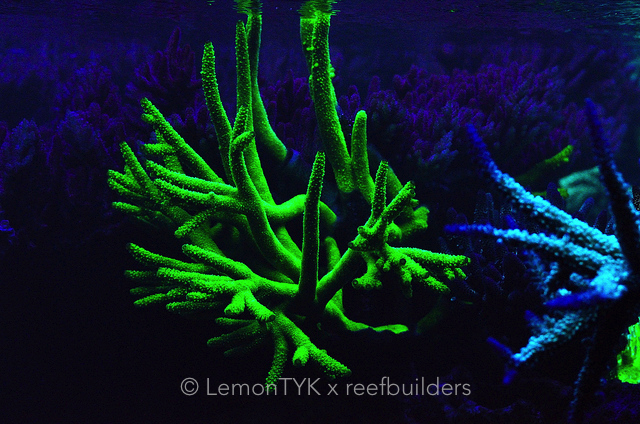The scintillating brilliance that exudes from a coral is without a doubt the clinching factor for decision making in purchasing, propagating or just old school showing off. Yet the colour magic registered by your retina may just be a facade, masquerading a different more exuberant brilliance that can only be seen under specific conditions of light. In this article we skim the surface of coral fluorescence in a manner most rudimentary, and take a look at some examples of fluorescent proteins displayed by the corals in the Triton display tank.

Coral fluorescence isn’t unfamiliar territory to the budding or advanced aquarist, and its presence is widely known and revered by coral collectors. The stunning radioactive glow brought upon by deep blue LEDs for example have quickly become both a marketing leverage as well as a tool for photography, research and of course providing another platform of home entertainment. The distribution of fluorescent proteins in the underlying tissue may appear in different patterns from that of the perceived appearance under regular lighting as well, lending a “one coral two look” effect which can be appreciated with the manipulation of two light settings.

The fluorescing phenomenon is brought upon by proteins within the coral tissue called fluorescent proteins, and in total there are nine known types. Of which, green fluorescent proteins (GFP) and cyan fluorescent proteins (CFP) are the most prevalent, with the former being the most abundant and present in a myriad of coral species and genera. Fluorescent proteins do not behave in the same way that regular pigments do, however.

Most corals appear colourful under light due to chromoprotein pigments, which are non-fluoresceing colourful pigments found in chromophores embedded within coral tissue. These pigments appear colourful because they reflect light, and take on different colours depending on the wavelengths in which they reflect. For example, a particular Acropora may appear blue because it reflects the blue wavelength of the visible light spectrum, while absorbing all other colours. Reflection of multiple wavelengths may yield various colour combinations as well, such as the appearance of purple being brought upon by the reflection of red and blue wavelengths.

Fluorescent proteins are slightly different however. Fluorescent pigments absorb light in the same way chromopigments do, but the absorption of light at a particular wavelength may cause excitation of these pigments, causing them to fluoresce. Fluorescence is an emission of light at a different wavelength from which was absorbed, and this causes a visible glow. Excitation however dies off almost immediately, usually within the span of a few nanoseconds once the source is removed. This means that fluorescence is only observed when the proteins are kept excited by a specific wavelength. Removal of which will result in termination and there is no residual fluorescence after source removal.
Green fluorescent proteins are the most prevalent types, and is found in a wide range of coral species and genera. Structurally it is very similar to cyan fluorescent proteins (CFP), and have an emission spectrum of 500-525nm. The mini gallery above shows the fluorescence of GFP in various coral species, both stony as well as soft. They are best observed in a completely dark environment, with the subjects lit only by deep blue LEDs or other lighting with similar wavelengths.

Cyan fluorescent proteins are the second major and most common type of fluorescent proteins, and as the name suggest, emit a beautiful cyan hue when excited. CFP emissions are expressed at lower light levels than GFP, and have emission wavelengths of 477-500nm. The Caulestra above when seen under deep blue LEDs in a dark tank shows a lustrous almost gem like quality as it emits light from the cyan proteins.
In this particular tank set up we observed CFP mostly in Caulestra, Wellsophyllia and a few Acropora and Montipora species. Acropora chesterfieldensis in particular shows remarkable coloration under such light conditions. The small gallery above shows a little more photos of these corals with CFP fluorescence being emitted.

Scratching the surface is a vast overstatement of this article, and invariably there are lots more to talk about with regards to coral fluorescence. This isn’t a topic we have much experience with, but Dana Riddle is an expert on coral fluorescence and his articles can be found on Advanced Aquarist with some searching, all of which extensively covers the science and intricacies of this wonderful phenomenon.
For coral enthusiasts, I apologise for this antiquated and rather truncated delivery of said topic. As the fish people would say, “blue lights sure make these corals purdy”. Indeed they do, and indeed it is.



